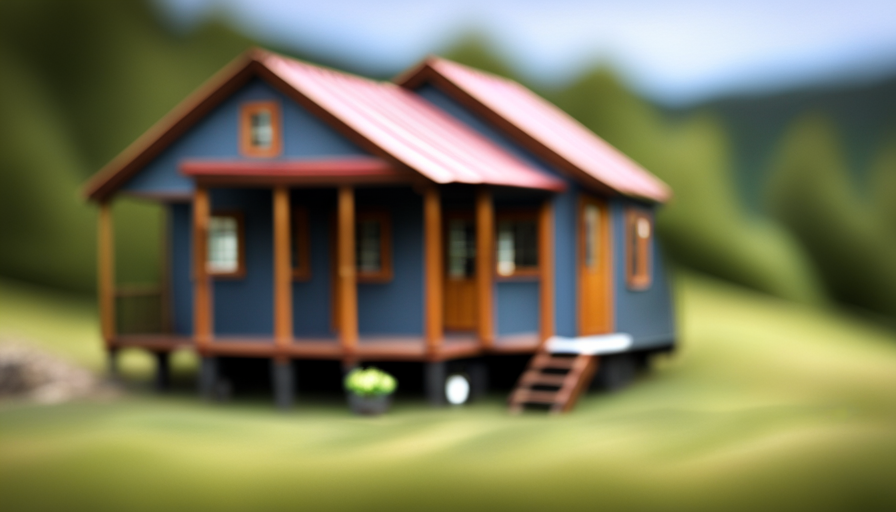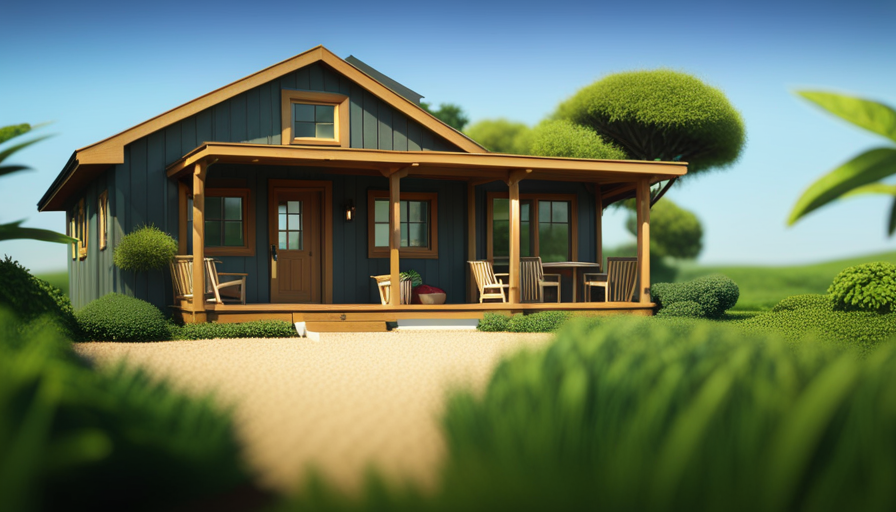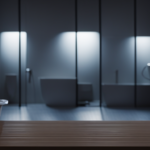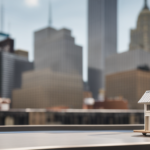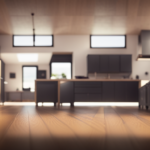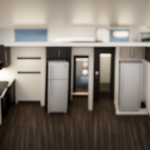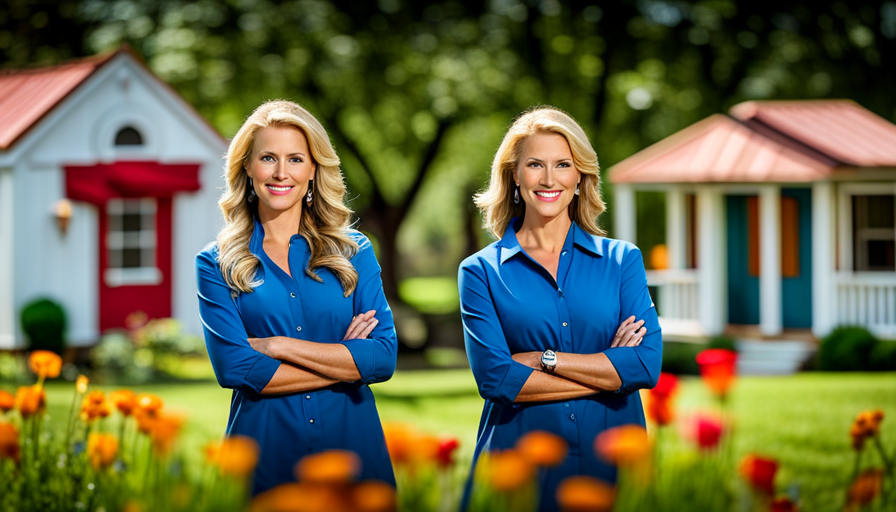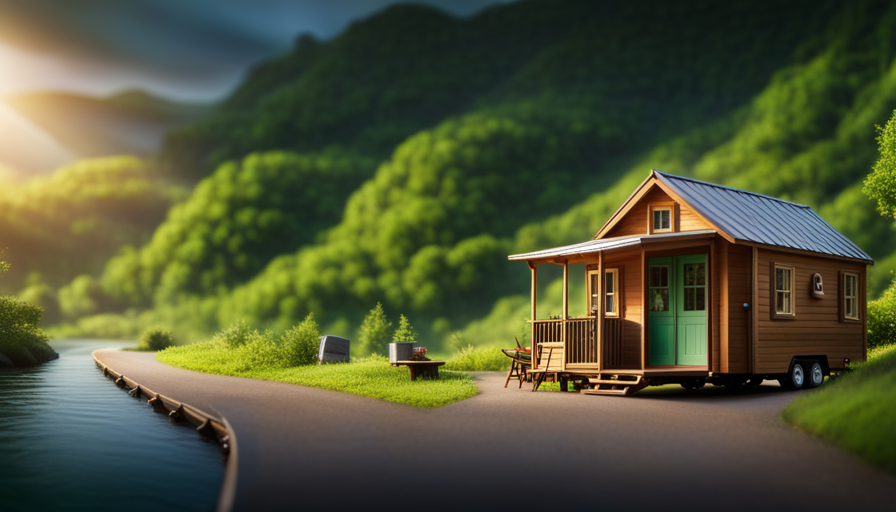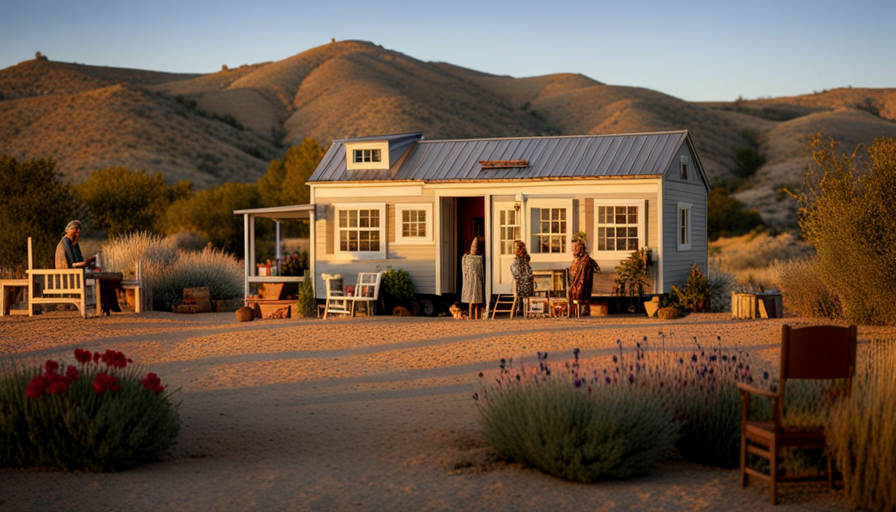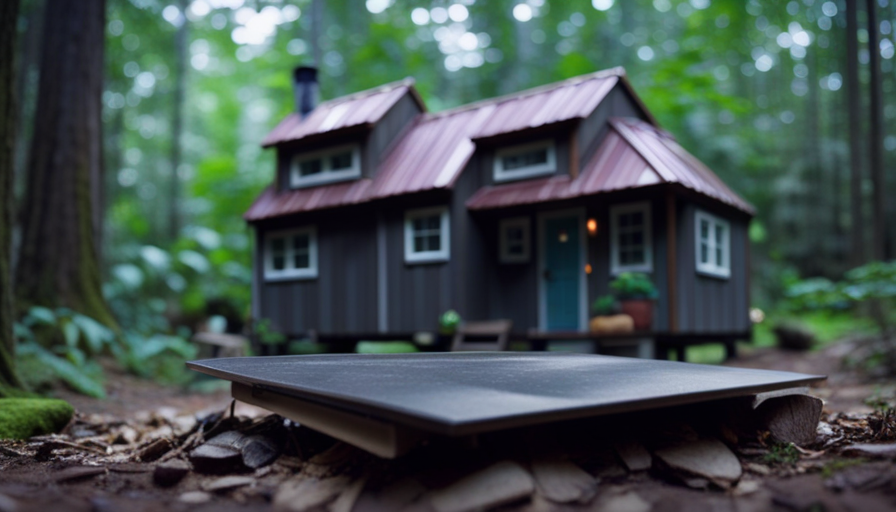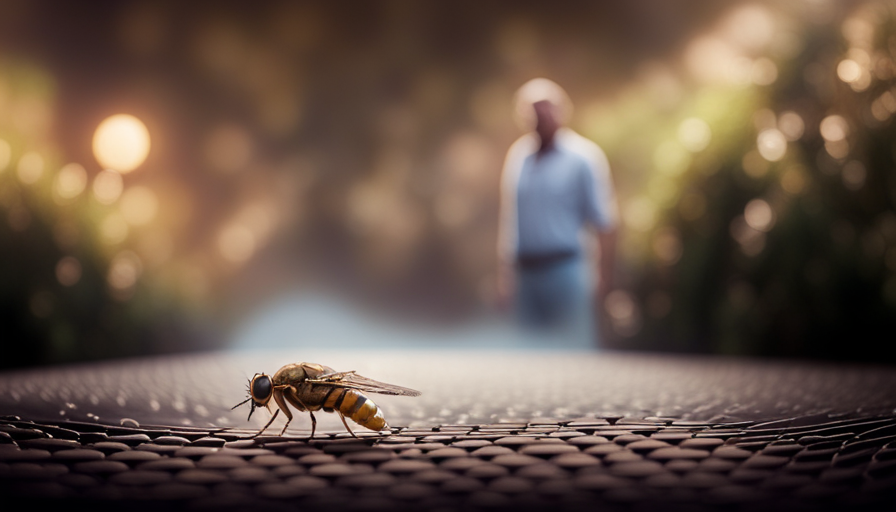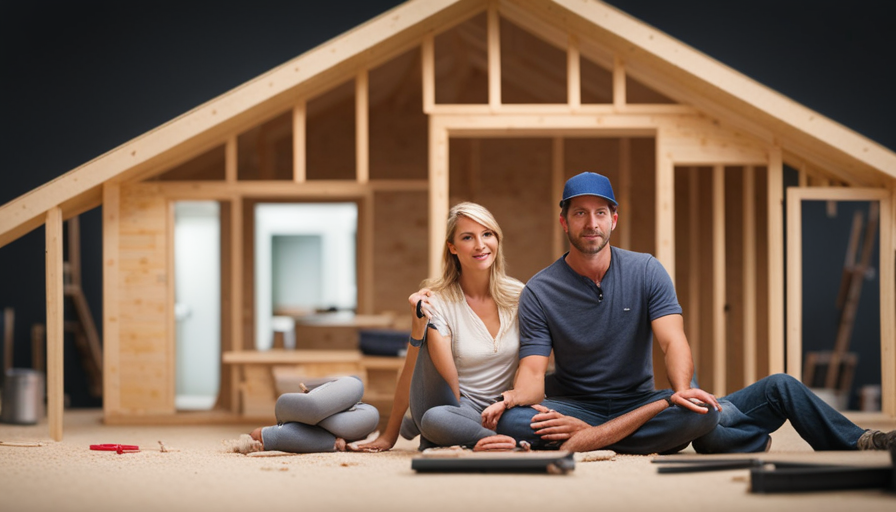Curious about the largest size a tiny house can be? Prepare to be surprised.
In the world of tiny house living, where less is more, there are no limits to what can be achieved. From compact and cozy dwellings to surprisingly spacious abodes, the possibilities are endless.
As a passionate advocate for the tiny house movement, I have delved deep into the world of small living spaces and discovered the secrets to maximizing every square inch. In this article, I will explore the benefits of tiny house living, reveal the size limitations of these miniature marvels, and share creative design strategies for maximizing space.
We will delve into examples of large tiny houses and uncover tips for living comfortably in a small space. So, get ready to embrace the tiny house revolution and discover just how big a tiny house can truly be.
Key Takeaways
- Tiny houses offer financial freedom with lower construction and maintenance costs.
- Limited space in tiny houses requires creative storage solutions.
- Multifunctional furniture and vertical storage options maximize space in tiny houses.
- Outdoor spaces allow for gardening opportunities and a closer connection to nature.
The Benefits of Tiny House Living
Living in a tiny house brings a multitude of benefits that make it an incredibly enjoyable lifestyle choice. One of the main advantages is the financial freedom it offers. With lower construction and maintenance costs, as well as reduced energy usage, tiny house living can save you a significant amount of money in the long run.
Another benefit is the minimalistic lifestyle it promotes. By downsizing your possessions, you can declutter your life and focus on what truly matters.
However, it’s important to acknowledge the challenges that come with tiny house living. Limited space can be a hurdle, requiring creative storage solutions and efficient use of every inch. Understanding the size limitations of tiny houses is crucial to maximizing the benefits of this lifestyle.
Understanding the Size Limitations of Tiny Houses
With size limitations, it’s incredible how much one can do when designing a compact dwelling. Tiny houses come with their own set of challenges, and understanding the size limitations is crucial.
One of the key considerations is maximizing storage. In a tiny house, every inch of space counts, so it’s important to make use of vertical storage options, built-in furniture with hidden compartments, and creative solutions like using the space under the stairs or installing overhead storage racks.
Another factor to consider is zoning regulations. Different areas have different regulations regarding the size and placement of tiny houses, so it’s essential to do thorough research and ensure compliance.
By understanding these limitations and working within them, one can create a functional and comfortable living space.
Transitioning into the next section about creative design strategies for maximizing space, there are numerous techniques that can be employed to make the most of every square inch.
Creative Design Strategies for Maximizing Space
One fascinating statistic to keep in mind is that compact dwellings can utilize up to 30% more space by implementing creative design strategies. Maximizing efficiency is key when it comes to designing tiny houses. By carefully considering the layout and flow of the space, as well as incorporating multifunctional furniture, every square inch can be utilized effectively. For example, a dining table that can also be used as a workspace or storage area can help maximize space in a small kitchen. Additionally, using built-in storage solutions, such as under-bed drawers or wall-mounted shelves, can help keep the space organized and clutter-free. Another strategy is to utilize vertical space by incorporating loft areas for sleeping or storage. By implementing these design strategies, tiny houses can feel spacious and functional. Transitioning into the subsequent section about examples of large tiny houses, it is interesting to see how these design concepts can be applied in larger spaces as well.
Examples of Large Tiny Houses
When it comes to large tiny houses, there are several key points to consider. The first is the customizable design options available, allowing homeowners to maximize their space and make it their own.
Additionally, outdoor areas can be used to expand the living space, creating a seamless connection between indoor and outdoor living.
Lastly, incorporating full-size appliances and amenities in a tiny house allows for a comfortable and convenient lifestyle.
These factors all contribute to making large tiny houses a viable option for those looking to downsize without sacrificing living space or amenities.
Customizable Tiny House Designs
Although compact in size, tiny houses can still be customized to fit the unique needs and preferences of their owners. One of the key advantages of tiny houses is the ability to incorporate customizable features and space-saving furniture that maximize the available space. From multi-functional built-in storage solutions to convertible furniture pieces, there are endless possibilities to optimize every square inch of a tiny house. To give you an idea of the customizable options, here is a table showcasing some popular features:
| Customizable Feature | Description |
|---|---|
| Lofted Sleeping Area | Utilizes vertical space for a separate sleeping area |
| Foldable Dining Table | Expands when needed and folds away when not in use |
| Sliding Walls | Allows for flexible room configurations |
| Built-in Shelving | Maximizes storage space |
| Pull-out Pantry | Provides additional storage for kitchen essentials |
By incorporating these customizable features, tiny house owners can create a space that perfectly suits their lifestyle and preferences. Expanding living space with outdoor areas allows for even more possibilities to enjoy the surrounding environment.
Expanding Living Space with Outdoor Areas
To expand your living space and make the most of your surroundings, consider adding outdoor areas such as a deck or patio. These additions can increase the usable square footage of your home by up to 30%. Outdoor entertainment spaces provide the perfect setting for hosting guests, enjoying meals al fresco, or simply relaxing and taking in the fresh air.
Additionally, these outdoor areas offer endless gardening opportunities. You can cultivate your own herbs, vegetables, or flowers by incorporating planter boxes or vertical gardening systems. This allows you to create a vibrant and thriving outdoor oasis.
The integration of outdoor spaces not only expands your tiny house’s living area but also enhances your overall lifestyle. It brings nature closer to your doorstep. As we explore the next section on incorporating full-size appliances and amenities, we can further optimize the functionality and comfort of your tiny house.
Incorporating Full-Size Appliances and Amenities
By incorporating full-size appliances and amenities, you can transform your living space into a luxurious oasis that will make you never want to leave.
One way to maximize space is by incorporating space-saving furniture, such as folding tables and multi-functional seating. These pieces can easily be tucked away when not in use, creating a more open and spacious feel.
Additionally, alternative energy solutions, such as solar panels and rainwater collection systems, can provide the necessary power and water for your appliances and amenities without relying on traditional utilities. This not only reduces your environmental impact but also saves you money in the long run.
With these innovative solutions, your tiny house can offer all the comforts and conveniences of a full-size home.
Now, let’s explore some tips for living comfortably in a tiny house without compromising on your lifestyle.
Tips for Living Comfortably in a Tiny House
Living in a tiny house can be surprisingly comfortable and bring a sense of fulfillment to your life. With the right strategies and mindset, you can make the most out of your small space. Here are some tips for living comfortably in a tiny house:
-
Maximize storage: Utilize vertical space and invest in clever storage solutions to keep your belongings organized and out of sight.
-
Efficient furniture: Choose multi-functional furniture pieces that can serve multiple purposes, such as a sofa that can also be converted into a bed or a dining table that can be folded away when not in use.
-
Embrace minimalism: Adopting a minimalist lifestyle will help you declutter and prioritize what truly matters to you.
-
Embrace the outdoors: Make use of outdoor spaces such as patios or gardens to expand your living area and create a sense of openness.
Transitioning into the next section about challenges and considerations for tiny house living, it’s important to be aware of the potential obstacles that may arise.
Challenges and Considerations for Tiny House Living
Living comfortably in a tiny house requires careful planning and organization. However, it’s important to acknowledge the challenges faced and the financial considerations that come with this lifestyle.
One of the biggest challenges is the limited space, which can make it difficult to store belongings and accommodate guests. Additionally, the lack of privacy can be a challenge for some individuals.
It’s important to consider the financial implications of tiny house living as well. While the initial cost of building or purchasing a tiny house may be lower than a traditional home, there are ongoing expenses to consider such as maintenance, utilities, and parking fees. It’s crucial to create a realistic budget and account for these costs to ensure a comfortable and sustainable tiny house living experience.
Looking ahead, the future of tiny house living holds exciting possibilities for those seeking a simplified and affordable lifestyle.
The Future of Tiny House Living
The future of tiny house living holds exciting possibilities, as the movement continues to gain popularity and community support.
More and more people are recognizing the benefits of downsizing and simplifying their lives, leading to a growing demand for tiny houses.
Additionally, the concept of tiny house villages and co-housing models is gaining traction, providing an opportunity for like-minded individuals to come together and create vibrant, sustainable communities.
Lastly, innovations in tiny house design and construction are constantly being made, allowing for even greater efficiency and creativity in small space living.
Growing Popularity and Community Support
With a tight-knit community and increasing popularity, it’s amazing to see how much support tiny houses are gaining. People are coming together to embrace this minimalist lifestyle, and it’s creating a sense of community engagement like never before.
The tiny house movement has sparked conversations and connections, as individuals share ideas, tips, and stories of their tiny house experiences. It’s truly inspiring to witness the support and encouragement that exists within this community.
In addition to the growing community, there’s also a push for more lenient zoning regulations to accommodate tiny houses. Many advocates are working tirelessly to address the legal barriers and promote the acceptance of tiny houses as a viable housing option. This effort is crucial in ensuring that more people have the opportunity to join the tiny house movement.
As we delve into the topic of tiny house villages and co-housing models, it becomes evident that the momentum and collaboration within the tiny house community are paving the way for innovative solutions to housing challenges.
Tiny House Villages and Co-Housing Models
Collaborative communities create cozy connections in compact villages and co-housing models. These innovative solutions to the housing crisis not only provide affordable housing options but also foster a strong sense of community. Tiny house villages and co-housing models offer a unique opportunity for individuals to live in close proximity to one another, sharing resources, skills, and support.
One key challenge in creating these communities is navigating tiny house zoning regulations. Many cities have strict regulations that limit the size and location of tiny houses, making it difficult for individuals to find suitable land to build their homes. However, there is a growing movement to change these regulations and create more opportunities for tiny house living.
In addition to the social benefits, tiny house villages and co-housing models also have a positive economic impact. These communities often support local businesses and contribute to the local economy through job creation and increased tourism.
Transitioning into the subsequent section about ‘innovations in tiny house design and construction’, it is clear that collaborative communities have paved the way for new and exciting developments in the tiny house movement.
Innovations in Tiny House Design and Construction
Innovative designers and builders are revolutionizing the way small homes are designed and constructed, creating a wave of exciting advancements in the tiny house movement.
One area where these innovators are making significant strides is in the development of innovative storage solutions. With limited space available, it’s crucial to maximize every inch, and designers are coming up with creative ways to do just that. From hidden compartments in walls to multi-functional furniture pieces, these storage solutions are allowing tiny homeowners to live comfortably without sacrificing functionality.
Another key aspect of innovation in tiny house design and construction is the use of sustainable building materials. With a focus on reducing environmental impact, builders are incorporating materials such as reclaimed wood, recycled metal, and eco-friendly insulation. These materials not only help to minimize waste and carbon emissions but also create healthier living spaces for tiny house dwellers.
Overall, the advancements in tiny house design and construction are truly impressive. With innovative storage solutions and sustainable building materials, tiny homeowners can enjoy a comfortable and eco-friendly living experience in their compact homes.
Frequently Asked Questions
What are the financial advantages of living in a tiny house?
Living in a tiny house offers numerous financial benefits and cost savings. By downsizing to a smaller space, you can significantly reduce your monthly mortgage or rent payments.
Additionally, the lower utility costs and maintenance expenses associated with a tiny house can lead to substantial long-term savings.
With careful planning and efficient use of space, you can enjoy a more affordable and financially sustainable lifestyle in a tiny house.
Are there any legal restrictions on where you can park a tiny house?
There are indeed legal restrictions regarding where you can park a tiny house. These restrictions vary depending on the jurisdiction and local regulations.
Different areas may have specific zoning laws that dictate where you can park a tiny house, such as designated tiny house communities or residential areas. Additionally, some places may require you to obtain special permits or meet certain size requirements for parking locations.
It’s important to research and adhere to the local regulations before parking your tiny house.
How do tiny houses impact the environment?
Tiny house construction and sustainable living practices have a significant impact on the environment. By utilizing renewable materials and energy-efficient systems, tiny houses minimize their carbon footprint. They are like a drop of water in a vast ocean, symbolizing the potential for positive change.
These homes promote minimalism and reduce waste, encouraging a more sustainable lifestyle. From solar panels to composting toilets, tiny houses showcase innovative solutions for eco-conscious living. Their small size also means less energy consumption, making them an environmentally responsible housing option.
Can you have pets in a tiny house?
Tiny house pets are allowed in most jurisdictions, but regulations may vary. It’s important to check with local authorities to ensure compliance with any size restrictions or pet limits.
Some tiny house communities may have specific rules regarding pets, so it’s crucial to research and understand the guidelines before getting a pet. Additionally, consider the size of the pet and how it will fit into the limited space of a tiny house.
Proper planning and consideration are key when deciding to have pets in a tiny house.
How do you handle storage in a tiny house?
When it comes to storage in a tiny house, I’ve learned that maximizing space is key. It’s all about getting creative with organization.
From utilizing vertical space with shelves and hooks to investing in multi-functional furniture with built-in storage compartments, there are countless ways to make the most of every inch.
Additionally, utilizing under-bed storage, wall-mounted organizers, and collapsible furniture can really help to optimize space. It’s all about finding clever solutions to keep everything organized and accessible.
Conclusion
In conclusion, living in a tiny house has its challenges, but it also offers a unique and rewarding lifestyle. From the benefits of minimalism to the creative design strategies for maximizing space, there are countless ways to make the most of a tiny house.
While it may seem counterintuitive, thinking big in a small space is key. Just like a seedling that grows into a mighty oak, a tiny house has the potential to be a sanctuary of comfort and joy.
So, embrace the possibilities and let your tiny house flourish.
Hi, I’m Emma. I’m the Editor in Chief of Tiny House 43, a blog all about tiny houses. While tree houses are often associated with childhood, they can be the perfect adult retreat. They offer a cozy space to relax and unwind, surrounded by nature. And since they’re typically built on stilts or raised platforms, they offer stunning views that traditional homes simply can’t match. If you’re looking for a unique and romantic getaway, a tree house tiny house might just be the perfect option.
